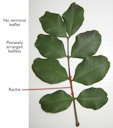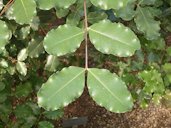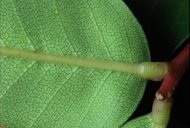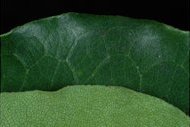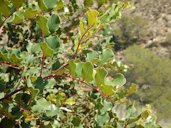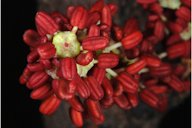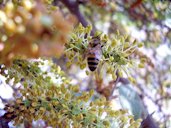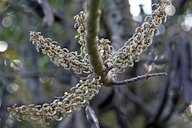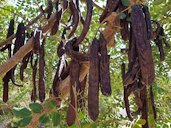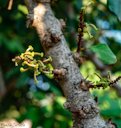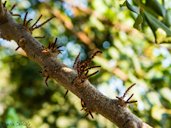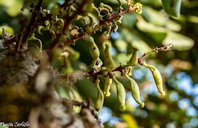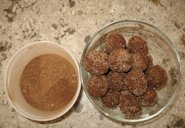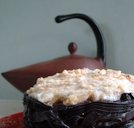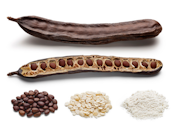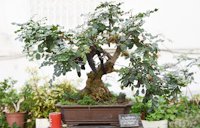| Carob - Ceratonia siliqua | |||||||||||||||||||||||||||||||||||||||||||||||||||||||||||||||||||
|---|---|---|---|---|---|---|---|---|---|---|---|---|---|---|---|---|---|---|---|---|---|---|---|---|---|---|---|---|---|---|---|---|---|---|---|---|---|---|---|---|---|---|---|---|---|---|---|---|---|---|---|---|---|---|---|---|---|---|---|---|---|---|---|---|---|---|---|
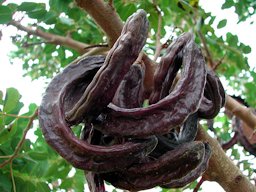 Fig. 1  Carob pods hanging off a carob tree (Ceratonia siliqua), Mallorca 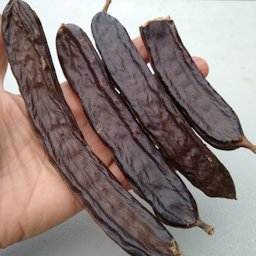 Fig. 2  Pods of the carob tree. C. siliqua are delicious, sweet, chewy and with a taste a little bit like a natural, healthful candy bar. 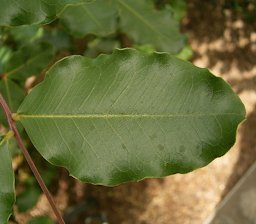 Fig. 3  C. siliqua 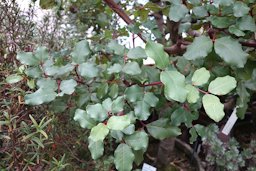 Fig. 4  Botanical specimen in the Botanischer Garten, Dresden, Germany 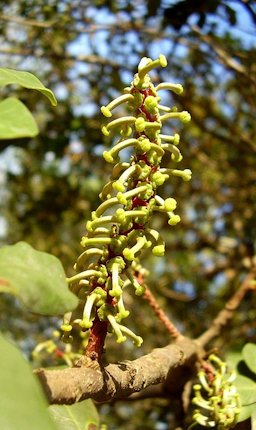 Fig. 15  C. siliqua female flowers. Israel Border Police memorial site near kibbutz Barkai. 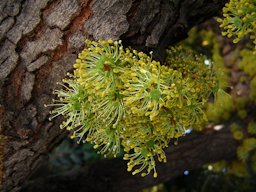 Fig. 16  Blüten eines Johannesbrotbaumes, male inflorescense of carob tree 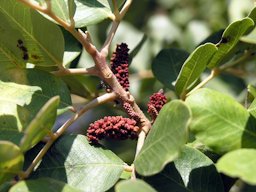 Fig. 17  Male flowers (unopened) on a carob tree in Cyprus, which emanate a strong cadaverine odor 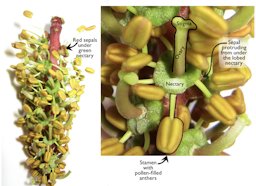 Fig. 18  Inflorescence with hermaphroditic flowers. flowers have both pistils (stigma, short style, ovary) and stamens (anthers on filaments). They lack petals, and their sepals are very short, obscured by the green nectary. 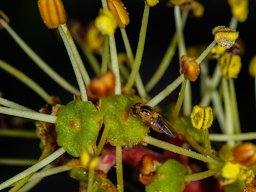 Fig. 19  Tiny wasp on carob flower 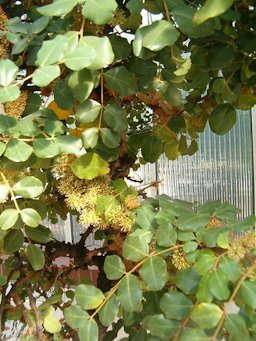 Fig. 26  C. siliqua habit Fig. 27  Ripe pods and flowering for next year's crop  Fig. 28  Unripe carob pods in Soller, Majorca, Spain. These C. siliqua legume pods, are about 6 inches (15 cm) long. 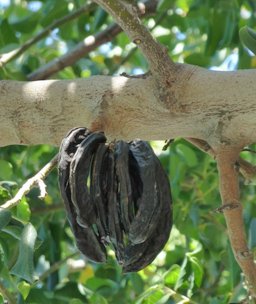 Fig. 29  C. siliqua, Turkey 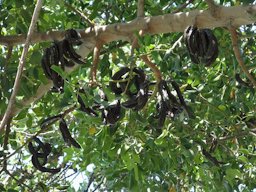 Fig. 30  Fig. 31 Carob pods: green (unripe) and brown (ripe) 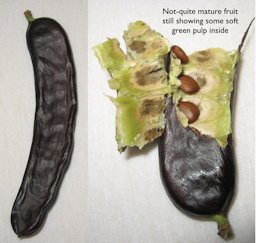 Fig. 32  Not-quite mature fruit still showing some soft green pulp inside 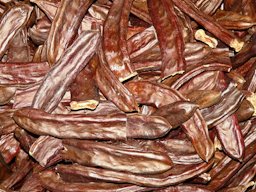 Fig. 33  Fig. 40  Keimling von Johannisbrot, seedling of carob, (C. siliqua) Fig. 41  Plàntules de garrofers, viver vell de les dunes de Guardamar  Fig. 42  A large carob tree in Sardinia, Italy 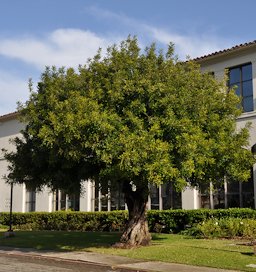 Fig. 43  C. siliqua tree Palo Alto, CA, Cal Poly Campus 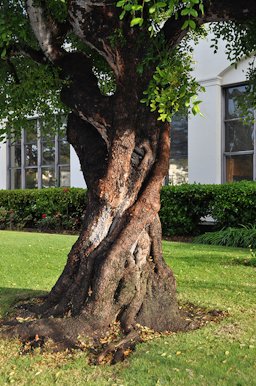 Fig. 44  C. siliqua tree 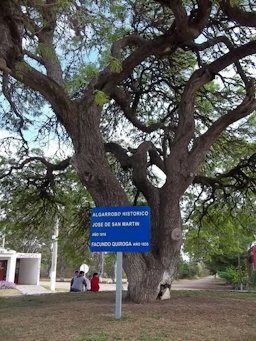 Fig. 45  El histórico algarrobo (carob tree) de Sarmiento cobijó bajo su sombra al Gral. San Martín en 1816, y al Gral. Facundo Quiroga en 1835. 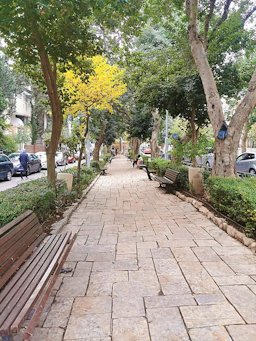 Fig. 46  The path between the carob trees on Ben Maimon Avenue in the Rehavia neighborhood 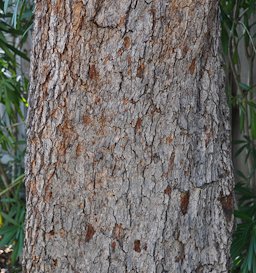 Fig. 47  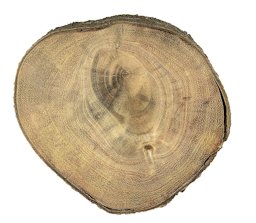 Fig. 48  C. siliqua wood. Muséum de Toulouse. 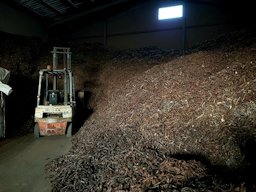 Fig. 49  Magatzem de garrofa a Teulada, Marina Alta, Spain. (Carob warehouse)  Fig. 50  Carob confections 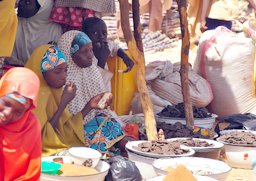 Fig. 60  This picture was snapped at a local market, in kano state depicting women selling locust beans (locally referred to as 'daddawa' in hausa language). | Scientific
name Ceratonia siliqua Pronunciation Ser-a-TOE-nee-a sa-LI-qua 14 Common names English: St. John’s bread, locust bean, carob tree, carob bean; French: caroube, caroubier; German: karuben, jaumjohannisbrot, jaum; Greek: charaoupi; Hindi: kharnub; Italian: carrubo; Malay: gelenggang; Mandarin: chiao-tou-shu; Portuguese: alfarrobeira; Spanish: caroba, garrover, algarrobo, garrofero; Thai: chum het tai; Turkish: charnup; Arabic: al-kharoubah, kharrub; Catalan: garrover, garrofer; Swedish: johannesbröd 2,10 Synonyms No synonyms are recorded for this name Family Fabaceae ⁄Leguminosae (pea family) 10 Origin Mediterranean basin and southwestern Asia USDA hardiness zones 9-11 7 Uses Food; shade or shelter; ornamental; intercropping; thickener, stabilizer, binder; gelling or dispersal agent 2 Height Up to 33 ft (10 m) high 2 Spread 30-40 ft (9-12 m) 7 Crown Broad semi-spherical 2 Plant habit Evergreen shrub or tree; prolific producer of basal trunk and root suckers (Fig. 7) 2,14 Growth rate 24 in. (61 cm) per year 7 Longevity May remain productive for 80-100 years; can survive for over a century 1,8 Trunk/bark/branches Thick trunk; brown rough bark; sturdy branches 2 Pruning requirement Little pruning is necessary due to the tree’s specific growth and fruiting habits 2 Leaves Leaves 4-8 in. (10-20 cm) long; alternate; dark green above, pale green beneath 2 Flowers Small, numerous; borne on old wood, even on the trunk; staminate, pistillate and hermaphrodite inflorescences 3,8 Fruit Brown, pod elongated, straight or curved; wrinkled surface, leathery when ripe; 10-13 hard seeds 2,3 Season Nov. - Jan. in California 6 Nutrient Content Light requirement Full sun 14 Soil tolerances Grows from rocky hillsides to deep sand or heavy loam; must have good drainage 1 pH preference Slightly acidic to highly alkaline Drought tolerance Extremely drought-tolerant; cannot withstand waterlogged conditions 1,2 Aerosol salt tolerance Tolerates salt laden air Soil salt tolerance Can tolerate up to 3% sodium chloride in the soil 8 Cold tolerance 2 °F (-4 °C) may kill young trees; mature tree can endure a temperature drop to 20 °F (-6.7 °C) 1,3 Plant spacing 30 ft (9 m) apart each way 1 Roots Extensive root system penetrates the soil deeply (Fig. 8) 2 Invasive potential * None reported Pest resistance Normally free from severe insect and disease troubles Known hazard None known Reading Material Carob, Fruits of Warm Climates Ceratonia siliqua, Agroforestree Database Carob tree, International Plant Genetic Resources Institute pdf The Situation Of The Carob Tree In Australia, Archives of the Rare Fruit Council of Australia Origin/Distribution The carob tree has been grown since antiquity in most countries of the Mediterranean basin, usually in mild and dry places with poor soils. Its value was recognized by the ancient Greeks, who brought it from its native Middle East to Greece and Italy, and by the Arabs, who disseminated it along the North African coast and north into Spain and Portugal. It was spread in recent times to other Mediterranean-like regions such as California, Arizona, Mexico, Chile and Argentina by Spaniards, to parts of Australia by Mediterranean emigrants and to South Africa and India by the English. 5 Description A long-lived evergreen and thermophilic (organisms with optimum growth temperatures between 65 and 80°C) tree thriving in habitats with mild Mediterranean climates. It grows well in warm temperate and subtropical areas, tolerates hot and humid coastal areas. It is a xerophytic species, well adapted to the ecological conditions of the Mediterranean region. C. siliqua, together with Olea europea var. sylvestris, forms one of the most characteristic associations of the lowest Mediterranean vegetation zone and is thus considered a climax community (Olea-Ceratonion). Areas suitable for C. siliqua should have a subtropical Mediterranean climate with cool, not cold, winters, mild to warm springs, and warm to hot, dry summers. 2 A saying from Cyprus puts this aptly, "plant an olive tree for your children and a carob tree for your grandchildren". 15
Fig. 5,6. Carob tree, C. siliqua, Judean Foothills, Israel Fig. 8. Extensive root system Leaves Leaves 3.9-7.9 in. (10-20 cm) long, alternate, pinnate, with or without a terminal leaflet. Leaflets 1.2-2.7 in. (3-7 cm) long, ovate to elliptic, 4-10 normally opposite pairs, coriaceous, dark green and shiny above, pale green beneath finely veined with margins slightly ondulate, tiny stipules. Petioles and rachis are reddish (Fig. 4,13). 2,14
Fig. 9. A single large carob leaf, with four pairs of leaflets. At dusk, leaflets fold up towards each other, like pairs of hands, thanks to the thick pulvinus at the base of each leaflet. Fig. 12. The front-top side (right-dark green) and reverse-bottom side (left) of a carob tree leaflet, from the C. siliqua plant. Fig. 13. Ceratonia siliqua. Santa Helada, Comunitat Valenciana, España. Fig. 14. C. siliqua L. - St. John's bread. Flowers Flowers green-tinted red, small, numerous, 1/4-1/2 in. (6-12 mm) long, spirally arranged along the inflorescence axis in catkin-like racemes borne on spurs from old wood and even on the trunk (cauliflory). Pentamerous symmetry with calyx but not corolla placed on a short pedicel. Calyx disc-shaped, reddish-green, bears nectaries. C. siliqua is a trioecious tree with some hermaphroditic forms; male, female and hermaphroditic flowers are generally borne on different trees. Unisexual and bisexual flowers are rare in the same inflorescence. The flowers are initially bisexual, but usually 1 sex is suppressed during the development of functionally male or female flowers. 2 Females consist of a pistil 1/4-1/3 in. (6-8.5 mm) on a disk and rudimentary stamens, 5 hairy sepals. Males consist of a nectarial disk, 5 stamens with delicate filaments hairy sepals. In the centre of the disk there is a rudimentary pistil. Hermaphrodite flowers a combination; containing a pistil and a complement of 5 stamens. 2
Fig. 20. Stages of development of female (F) and male (M) flowers of carob (from Haselberg 1988) Fig. 21. C. siliqua (female flowers), Oahu, Keolu Fig. 22. St. John's bread, male flower close-up Fig. 23. C. siliqua male flowers (open), Kibbutz Barkai, Israel Fig. 24. Bee on C. siliqua male flowers Fig. 25. Female flowers habit Fruit The pod is light to dark-brown, oblong, flattened, straight or slightly curved, with a thickened margin; 4 to 12 in. (10-30 cm) long, 3/4 to 1 in. (1-2.5 cm) wide, glossy, tough and fibrous. It is filled with soft, semi-translucent, pale-brown pulp, scant or plentiful, and 10 to 13 flattened, very hard seeds which are loose in their cells and rattle when the pod is fully ripe and dry. The unripe pod is green, moist and very astringent; the ripe pod sweet when chewed (avoiding the seeds) but the odor of the broken pod is faintly like Limburger cheese because of its 1.3% isobutyric acid content. The soft brownish pulp may contain up to 50% sugar. 1 Pods are brown with a wrinkled surface and are leathery when ripe. The pulp comprises an outer leathery layer (pericarp) and softer inner region (mesocarp). Seeds occur in the pod transversally, separated by mesocarp. 5 The green pods are much heavier than the ripe ones, containing about 70% water whereas pod water content at maturity is about 12-18%. 5
Fig. 34. Jardí del Pont de la Via de Teulada, garrofes Fig. 35. In ancient Greece and Rome, dry carob seeds provided a standardized weight for jewelry, which we now call the carat 6 Fig. 36. Important parts of the carob pod (A), section of pod (B) and seed (C) Fig. 37,38,39. From female flower to fruit formation, Tarsus, Turkey
"Here's a candy bar that grows on a tree! These sweet, chocolate-y tasting treats are carob pods, and they really do taste like a natural, healthful version of a candy bar. When you bite into a carob pod, it has a pleasant chewiness, and a sweet, candy-like flavor that's close to chocolate (but not exactly the same), along with a nutty taste, and hints of caramel and coffee/mocha." "Carob is a tree is in the bean family, so the fruits have a roughly similar structure as a green bean, except with carob the part you eat is the dark, sweet flesh of the bean pod itself, not the row of small "bean seeds" within. (Bite GENTLY into a carob pod - those seeds are very hard. You soon learn to chew around the seeds and spit them out.) Carob is such a perfect food in its natural, unprocessed form, the whole pod straight off the tree - it puzzles me why grocery stores almost never sell it this way. If you can find carob at all in stores, it's generally as roasted, ground carob flour, not whole pods. There's nothing wrong with carob powder, it can be a good way to incorporate carob into recipes, but whole, raw carob pods just taste better." 9 Varieties The most promising female cultivars studied at IRTA (Institut de Recerca i Tecnologia Agroalimentàries) are: ‘Rojal’ (Spain), ‘Duraió’ (Spain), ‘Mulata’ (Portugal), ‘AIDA’ (Portugal) and ‘Sayalonga’ (Spain). Other cultivars like ‘Banya de Cabra’ (Spain), ‘Matalafera’ (Spain), ‘Galhosa’ (Portugal) and ‘Tylliria’ (Cyprus) also show some commercially interesting characteristics (Tous et al. 1996). As promising hermaphrodite pollinating cultivars,‘Clifford’ (California), ‘Santa Fe’, (California), ‘Ramillete’ (Spain), and ‘A-19’ can be considered. Some outstanding cultivars from different origins like ‘Amele’ (Italy), ‘Sfax’ (Tunisia), ‘Tylliria’, ‘Casuda’, ‘Santa Fe’ (California) and ‘Clifford’ (California) perform well in many countries. This shows that carob cultivars are able to adapt outside their region of origin. 5 Harvesting The pods must be harvested before winter rains. They are shaken down by means of a long pole with a terminal hook to grasp the branches. Those that don't fall readily are knocked off with the pole. The pods are caught on canvas sheets laid on the ground. This is a delicate task because the trees are flowering at the same time and care has to be taken not to damage the flowers and the next year's crop (Fig. 27). Then they are sun-dried for 1 or 2 days until the moisture content is reduced to 8% or below and then go through a kibbling process–crushing and grading into 4 categories: cubed, medium-kibbled, meal, and seed kernels. 1,13 It has to be realised that the Carob tree will bear heavy crops in alternate years and that yields will be variable from season to season. 15 Pollination In a planting of female trees, one male should be included for every 25 or 30 females. In southern Europe, branches from male trees are grafted onto some of the females in an orchard instead of interplanting male trees. 1 Pollen dispersal is by insects, mainly bees, flies, wasps and night-flying moths. Flowers of all 3 types secrete nectar; the volume of nectar and its sugar content are higher in female flowers than in male. Male and hermaphroditic flowers emit a semen-like odour that attracts insects. 2 Propagation The seeds used for sowing should be completely ripe and extracted from pods of the last harvest. 4 The carob is a trioecious tree with staminate, pistillate and hermaphrodite inflorescences on different trees. In traditional orchards male branches are grafted on female trees to provide pollen in situ. The carob, like the pistachio, matures slowly and most budded cultivars begin to bear in the 5-6th year after planting. It is also a strongly alternate-bearing species, particularly when growing conditions are poor. 3 The three main fruit traits that distinguish domesticated carobs from their wild relatives are larger bean size, more pulp and greater sugar content. Increase in the size and number of seeds less evident. These pod features together with productivity and environmental adaptation seem to have been the most important selection criteria for growers. 5 Planting Tolerant of moderate soil alkalinity, but will show foliar chlorosis in alkaline soils if the soils are chronically wet as might be the case around lawns. 14 If male and hermaphroditic trees are planted as pollinators they must be interspersed around and within the orchard in a regular pattern. It is important to use different types of male or hermaphroditic pollinators to overlap with female cultivar bloom, as main cultivars often display a long blooming season of 3-4 months. Since male trees have a shorter flowering period than hermaphrodites, the latter usually show better overlapping. 2 Pruning The carob tree is a species that needs little pruning, unlike other fruit and nut trees, which require pruning annually. After the basic framework of the tree has been established only light pruning is necessary. This fact is due to carob’s specific growth and fruiting habits. 4 Conservatively raise the crown base as needed and remove any epicormic shoots (sucker growth). 14 Irrigation Noted for its drought resistance, the plant is especially useful where irrigation is impractical or rainfall unreliable. However, unless irrigated, the fruits are dry and shrivelled, having little commercial value, and the yields are very low. Although drought-resistant, C. siliqua trees do not bear commercial crops unless they receive at least 20-22 in. (500-550 mm) per year, but 14 in. (350 mm) of annual rainfall is considered enough for fruit set. The tree’s extensive root system penetrates the soil deeply; roots develop under stressful conditions to explore deeper layers where water may be available; it can thus survive long periods of drought. In addition the leaves can maintain turgor under situations of drought, using different strategies according to the season. 2 Pests/Diseases C. siliqua is normally free from severe insect and disease troubles and traditionally is a crop that is not sprayed. Food Uses Apart from being chewed as a sweetmeat, carob pods are processed to a cocoa-like flour which is added to cold or heated milk for drinking. It has been combined with wheat flour in making bread or pancakes. A flour made by beating the seeded pods is high in fiber and has been utilized in breakfast foods. The finer flour is also made into confections, especially candy bars. The pods, coarsely ground and boiled in water yield a thick, honey-like sirup, or molasses. 1 Finely-ground pods make a sweet nutritious human food, and are used in a similar manner to cocoa in cakes, drinks, puddings, breakfast cereals, and candy. The carob powder has more vitamins, minerals, and fewer fats, carbohydrates, and calories than chocolate made with cocoa. 3 The seeds constitute 10 to 20% of the pod. They yield a tragacanth-like gum (manogalactan), called in the trade "Tragasol", which is an important commercial stabilizer and thickener in bakery goods, ice cream, salad dressings, sauces, cheese, salami, bologna, canned meats and fish, jelly, mustard, and other food products. The seed residue after gum extraction can be made into a starch- and sugar-free flour of 60% protein content for diabetics. 1 Carob is a great low-fat alternative to chocolate. It is naturally sweet and does not require any additional sweeteners. Unlike chocolate, carob doesn’t contain stimulants such as caffeine and theobromine.
Fig. 51. A bottle of Maltese carob liqueur with the north coast of Gozo Island in the background Fig. 52. Carob mocha brewing in a French press Fig. 53. Carob peanut balls (right) and carob powder (left); this batch was rolled in sugar for some sparkle; sugar is not necessary for taste because carob is naturally sweet Fig. 54. Carob chunk caramel Blondie trifle Fig. 55. Carob covered vegan macaroons Fig. 56. Vegan carob beetroot cake with two tone cocoraspberry tea and almond vanilla buttercream Fig. 57. A commercial South African product made from carob tree pods and rice. Medicinal Properties ** Tannins extracted from the pulp act as an anti-diarrhoetic. Ground pulp and seed endosperm are used in the preparation of pharmaceutical products. 2 Other Uses Pods: The pods are relished by horses, cattle, pigs, goats and rabbits. Whole pods are broken up in a hammermill in order to crush the seeds as well. Because of the tannin content, carob pods should constitute no more than 10% of total feed, other-wise they will depress growth rate. They cannot be fed to chickens. The flour is often utilized in dog biscuits. Great quantities of pods have been imported into the United States for flavoring uncured tobacco. 1 Seeds: The seed gum is much employed in the manufacture of cosmetics, pharmaceutical products, detergents, paint, ink, shoe polish, adhesives, sizing for textiles, photographic paper, insecticides and match heads. It is also utilized in tanning. Where rubber latex is produced, the gum is added to cause the solids to rise to the surface. It is also used for bonding paper pulp and thickening silkscreen pastes, and some derivatives are added to drilling mud. It has many other actual or potential applications. 1 Fodder: C. siliqua pods provide fodder for ruminants and non-ruminants. Endosperm and embryo of the seed can be ground and used for pet food. The fodder is now being used in zero-grazing in Mediterranean countries. 2 Wood: The heartwood is hard and close-grained. It is prized for turnery and cabinetwork. As a fuel it burns slowly and makes excellent charcoal. It yields algarrobin, which gives textiles a light-brown hue. 1
Fig. 58. Horse feeding pellets made of oats and C. siliqua. Processes Carob pods are removed manually or mechanically from the branches and collected in nets placed under the trees. Harvesting must be done carefully to avoid damaging the next year's flowers, which are fragile and close to the ripe pods. The fallen pods are air-dried for 48-72 h in a ventilated area. 11 Once dried (about 92% DM), the pods are brought to the processing plant where they are crushed to separate the seeds from the pulp. The pulp is ground to different sizes depending on the end market (feed or food). For animal feeding, whole pods may also be hammer-milled into carob bean flour or carob bean meal. The seeds have a hard coat that must be removed by acid treatment or roasting. The dehulled seeds are then split into endosperm, which is ground to produce gum, and germs, which are ground and dried to make carob germ meal. 5
Note on terminology There are four main carob feed products: whole carob pods, carob pulp (carob kibbles, deseeded carob pods), carob germs (carob germ meal) and the less common carob seeds. The terms carob pod meal and carob bean meal used in the literature often refer to both the whole pods and the deseeded pods (and possibly the germ meal to some extent). The term bean is particularly confusing because it concerns the whole pod and not just the seeds. Likewise, the term carob bean husks may refer to the deseeded pod (including the pulp), rather than just the pod covering. 12 General The scientific name of the carob tree derives from the Greek ‘keras’, horn, and Latin ‘siliqua’, alluding to the hardness and shape of the pod. The common name originates from the Hebrew-'kharuv’, from which other vernacular names are derived. 2 Carob beans were a standard in the ancient world for weighing small quantities. The Greek measure was the equivalent of the Roman siliqua, which was one-twenty-fourth of a golden solidus of Constantine; hence karat took on a sense of "a proportion of one twenty-fourth, a twenty-fourth part," especially in expressing the fineness of gold when used as jewelry, and thus is became a measure of gold purity (1550s): 18-carat gold is eighteen parts gold, six parts alloy; 14-carat gold is 10/24ths alloy, etc. 4 The word carob comes from Middle French carobe (modern French caroube), which borrowed it from Arabic خَرُّوبٌ (kharrūb, "locust bean pod"), ultimately perhaps from Akkadian language kharubu or Aramaic kharubha, related to Hebrew harubh. Ceratonia siliqua, the scientific name of the carob tree, derives from the Greek kerátiοn κεράτιον 'fruit of the carob (from keras κέρας 'horn'), and Latin siliqua 'pod, carob'. 13 A Ceratonia siliqua in Los Angeles is registered as a California Big Tree. It measures 52 feet high, with a trunk circumference of 185 inches and a crown spread of 62 feet. 7
Fig. 61. Algarrobo. Bonsai, Jardín Museo del Bonsai de Almuñécar. Algarrobo con flor y fruto. (Ceratonia siliqua with flowers and fruit) Further Reading Carob, Progress in New Crops, Purdue University The Carob, Archives of the Rare Fruit Council of Australia Carob Botanical Art List of Growers and Vendors | ||||||||||||||||||||||||||||||||||||||||||||||||||||||||||||||||||
| Bibliography 1 Fruits of Warm Climates. Julia F. Morton. Miami, 1987. 2 Orwa, C., et al. "Ceratonia siliqua L." Agroforestree Database: a tree reference and selection guide, version 4.0, 2009, Agroforestry, old.worldagroforestry.org/treedb2/AFTPDFS/Ceratonia_siliqua.PDF. Accessed 18 Feb. 2020. 3 Tous, Joan, and Louise Ferguson. "Mediterranean Fruits." Progress in New Crops, Edited by J. Janick, pp. 416-430, 1996, NewCROP™, hort.purdue.edu/newcrop/proceedings1996/V3-416.html. Accessed 1 Mar. 2020. 4 Harper, Douglas. "Carat." Online Etymology Dictionary, www.etymonline.com/search?q=carat. Accessed 2 Mar. 2020. 5 Batlle, I., and J. Tous. "Carob tree. Ceratonia siliqua L." Promoting the conservation and use of underutilized and neglected crops, 17, Institute of Plant Genetics and Crop Plant Research, Gatersleben/International Plant Genetic Resources Institute, Rome, Italy, 1997, IPGRI, www.bioversityinternational.org/fileadmin/user_upload/online_library/publications/pdfs/347.pdf. Accessed 3 Mar. 2020. 6 Preston, Katherine, A. "Pirates of the Carob Bean." The Botanist in the Kitchen, 28 Jan. 2018, (CC BY-NC-SA 3.0), botanistinthekitchen.blog/2018/01/28/pirates-of-the-carob-bean/. Accessed 3 Mar. 2020. 7 SelecTree. "Ceratonia siliqua Tree Record." 1995-2020, selectree.calpoly.edu/tree-detail/ceratonia-siliqua. Accessed 7 Feb. 2020. 8 The Encyclopedia of Fruit & Nuts. Edited by Jules Janick and Robert E. Paull, Cambridge, CABI, 2008. 9 Hepworth, Craig. "Carob." Florida Fruit Geek, floridafruitgeek.com/. Accessed 7 Feb. 2020. 10 "Taxon: Ceratonia siliqua L." USDA, Agricultural Research Service, National Plant Germplasm System, Germplasm Resources Information Network (GRIN-Taxonomy), National Germplasm Resources Laboratory, Beltsville, Maryland, 2020, U.S. National Plant Germplasm System, npgsweb.ars-grin.gov/gringlobal/taxonomydetail.aspx?id=9918. Accessed 28 Mar. 2020. 11 Shepperd, W. D. "Ceratonia siliqua L. Carob." USDA FS Agriculture Handbook 727, The Woody Plant Seed Manual, a handbook on seeds of trees and shrubs, 2008, USDA Forest Service, www.fs.usda.gov/nsl/Wpsm%202008/C%20genera%201.pdf. Accessed 29 Mar. 2020. 12 Heuzé V., et al. "Carob (Ceratonia siliqua)." Feedipedia, a programme by INRA, CIRAD, AFZ and FAO, 2016, Last updated on April 7, 2016, www.feedipedia.org/node/320. Accessed 29 Mar. 2020. 13 BA Cultnat. "Etymology and history of Ceratonia siliqua L." Bibliotheca Alexandrina, EOL, (CC BY-NC-SA 3.0), eol.org/pages/418096/articles. Accessed 29Mar. 2020. 14 "Ceratonia siliqua." Arizona State University, www.public.asu.edu/~camartin/plants/Plant%20html%20files/ceratoniasiliqua.html. Accessed 30 Mar. 2020. 15 Beaton, Scott A. "The Carob." Archives of the Rare Fruit Council of Australia, Mar. 1988, rfcarchives.org.au/Next/Fruits/Carob/Carob3-88.htm. Accessed 30 Mar. 2020. Video v Hepworth, Craig. "Carob." Florida Fruit Geek, floridafruitgeek.com/. Accessed 7 Feb. 2020. Photographs Fig. 1 Chixoy. "Carob pods hanging off a carob tree (Ceratonia siliqua), Mallorca." Wikipedia, via Wikimedia Commons, 29 Oct. 2006, GFDL, (CC BY-SA 3.0), en.wikipedia.org/wiki/Carob#/media/File:Garroves.JPG. Accessed 2 Mar. 2020. Fig. 2 Hepworth, Craig. "Pods of the carob tree, Ceratonia siliqua are delicious, sweet, chewy and with a taste a little bit like a natural, healthful candy bar." Florida Fruit Geek, floridafruitgeek.com/fabaceae-the-bean-family/. Accessed 7 Feb. 2020. Fig. 3 Vincentz, Frank. "Ceratonia siliqua." Wikimedia Commons, 18 Sept. 2007, GFDL, (CC BY-SA 3.0), commons.wikimedia.org/wiki/File:Ceratonia_siliqua_01_ies.jpg. Accessed 4 Mar. 2020. Fig. 4 Daderot. "Botanical specimen in the Botanischer Garten, Dresden, Germany." Wikimedia Commons, 10 Dec. 2013, (CC0), commons.wikimedia.org/wiki/File:Ceratonia_siliqua_-_Botanischer_Garten,_Dresden,_Germany_-_DSC08465.JPG. Accessed 27 Mar. 2020. Fig. 5 Huey, Randy. "Carob Tree, Ceratonia siliqua." iNaturalist Research Grade Observations, Judean Foothills, Israel, 26 Nov. 2019, (CC BY-NC 4.0), Image cropped, www.inaturalist.org/observations/38186624. Accessed 29 Mar. 2020. Fig. 6 Frumkin, Ron. "Carob Tree, Ceratonia siliqua." iNaturalist Research Grade Observations, 13 Nov. 2018, (CC BY-NC 4.0), www.inaturalist.org/observations/28114686. Accessed 29 Mar. 2020. Fig. 7 bobasil. "Carob Tree, Ceratonia siliqua." iNaturalist Research Grade Observations, Jerusalem, Israel, 13 Jan. 2020, (CC BY-NC 4.0), www.inaturalist.org/observations/37561727. Accessed 29 Mar. 2020. Fig. 8 PhotoLanda. "Ceratonia siliqua L." CC Search, via Flickr, (CC BY-SA 2.0), search.creativecommons.org/photos/03aa3eab-c0de-42c4-ab46-7005d3f6ac06. Accessed 30 Mar. 2020. Fig. 9 Preston, Katherine, A. "A single large carob leaf, with four pairs of leaflets. At dusk, leaflets fold up towards each other, like pairs of hands, thanks to the thick pulvinus at the base of each leaflet." Pirates of the Carob Bean, 28 Jan. 2018, The Botanist in the Kitchen, (CC BY-NC-SA 3.0), Image cropped, botanistinthekitchen.blog/2018/01/28/pirates-of-the-carob-bean/. Accessed 3 Mar. 2020. Fig. 10 Vincentz, Frank. "Ceratonia siliqua." Wikimedia Commons, 18 Sept. 2007, GFDL, (CC BY-SA 3.0), commons.wikimedia.org/wiki/File:Ceratonia_siliqua_03_ies.jpg. Accessed 4 Mar. 2020. Fig. 11,12,14,22 Goldman, Doug. "Ceratonia siliqua L. - St. John's bread." USDA, NRCS, National Plant Data Team, Greensboro, NC 27401-4901 USA, 2020, CESI3, Aug. 24, 2012, The PLANTS Database, plants.usda.gov/. Accessed 27 Mar. 2020. Fig. 13 Multivac42. "Ceratonia siliqua. Santa Helada, Comunitat Valenciana, España." Flickr, 25 Mar. 2016, (CC BY-NC-ND 2.0), www.flickr.com/photos/ameztegui/37269737265. Accessed 6 Jan. 2021. Fig. 15 rickjpelleg. "Ceratonia siliqua female flowers. Israel Border Police memorial site near kibbutz Barkai." Wikimedia Commons, 15 Nov. 2006, (CC BY-SA 3.0), commons.wikimedia.org/wiki/File:Ceratonia_siliqua_female_flowers_a-RJP.jpg. Accessed 3 Mar. 2020. Fig. 16 Frente. "Blüten eines Johannesbrotbaumes, blossoms of carob tree." Wikimedia Commons, 13 Oct.014, (CC BY-SA 2.0 de), commons.wikimedia.org/wiki/File:Blooming_Karupia2.jpg. Accessed 3 Mar. 2020. Fig. 17 Seminsky. "Male flowers on a carob tree in Cyprus, which emanate a strong cadaverine odor." Wikipedia, 26 Oct. 2013, Public Domain, en.wikipedia.org/wiki/Carob#/media/File:Blooming_carob_tree.jpg. Accessed 3 Mar. 2020. Fig. 18 Preston, Katherine, A. "Inflorescence with hermaphroditic flowers. Flowers have both pistils (stigma, short style, ovary) and stamens (anthers on filaments). They lack petals, and their sepals are very short, obscured by the green nectary." Pirates of the Carob Bean, 28 Jan. 2018, The Botanist in the Kitchen, (CC BY-NC-SA 3.0), Image cropped, botanistinthekitchen.blog/2018/01/28/pirates-of-the-carob-bean/. Accessed 3 Mar. 2020. Fig. 19 Navarro, Jose Ignacio Martinez. "Tiny Wasp On Carob Flower." Wikimedia Commons, via Archive Team, 23 Nov. 2014, (CC BY-SA 3.0), commons.wikimedia.org/wiki/File:Tiny_Wasp_On_Carob_Flower_(90808101).jpeg. Accessed 29 Mar. 2020. Fig. 20 Batlle, I., and J. Tous. "Stages of development of female (F) and male (M) flowers of carob (from Haselberg 1988." Promoting the conservation and use of underutilized and neglected crops, 17, Institute of Plant Genetics and Crop Plant Research, Gatersleben/International Plant Genetic Resources Institute, Rome, Italy, 1997, IPGRI, www.bioversityinternational.org/fileadmin/user_upload/online_library/publications/pdfs/347.pdf. Accessed 3 Mar. 2020. Fig. 21 Starr, Forest, and Kim. "Ceratonia siliqua (leaves and flowers). Location: Oahu, Keolu." Wikimedia Commons, 10 Aug. 2006, (CC BY 3.0), commons.wikimedia.org/wiki/File:Starr_060810-8544_Ceratonia_siliqua.jpg. Accessed 27 Mar. 2020. Fig. 23 rickjpelleg. "Ceratonia siliqua male flowers. Israel Border Police memorial site near kibbutz Barkai." Wikimedia Commons, 15 Nov. 2006, (CC BY-SA 3.0), commons.wikimedia.org/wiki/Ceratonia_siliqua#/media/File:Ceratonia_siliqua_male_flowers_05-RJP.jpg. Accessed 3 Mar. 2020. Fig. 24 rickjpelleg. "Bee on Ceratonia siliqua male flowers." Wikimedia Commons, 15 Nov. 2006, (CC BY-SA 3.0), commons.wikimedia.org/wiki/Ceratonia_siliqua#/media/File:Ceratonia_siliqua_bee_on_male_flower_02-RJP.jpg. Accessed 3 Mar. 2020. Fig. 25 Schaefer, Hans Peter. "Johannisbrotbaum, Blüte/Carrubo, infiorescenze." Wikimedia Commons, Oct. 2006, GFDL, (CC BY-SA 3.0), commons.wikimedia.org/wiki/File:Johannisbrotbaum_bluete.jpg. Accessed 4 Mar. 2020. Fig. 26 User:BotBln. "Ceratonia siliqua Habitus." Wikimedia Commons, 9 June 2007, GFDL, (CC BY-SA 3.0), commons.wikimedia.org/wiki/File:Ceratonia_siliqua_Habitus_Bln0906b.JPG. Accessed 27 Mar. 2020. Fig. 27 Doglio, Stefano. "Carob Tree, Ceratonia siliqua." iNaturalist Research Grade Observations, 5 Oct. 2014, (CC BY-NC 4.0), www.inaturalist.org/observations/909772. Accessed 29 Mar. 2020. Fig. 28 Pingstone, Adrian. "Unripe carob pods in Soller, Majorca, Spain. These Ceratonia siliqua legume pods, photographed in mid-June, are about 6 inches (15 cm) long." Wikimedia Commons, June 2010, Public Domain, commons.wikimedia.org/wiki/File:Carob_tree_unripe_pods_in_majorca_arp.jpg. Accessed 4 Mar. 2020. Fig. 29 Dilmen, Nevit. "Ceratonia siliqua, Turkey." Wikimedia Commons, 9 Aug.2013, GFDL, (CC BY-SA 3.0), commons.wikimedia.org/wiki/File:Ceratonia_siliqua_Keciboynuzu_1370983_Nevit.jpg. Accessed 4 Mar. 2020. Fig. 30 Dilmen, Nevit. "Ceratonia siliqua, Turkey." Wikimedia Commons, 9 Aug.2013, GFDL, (CC BY-SA 3.0), Image cropped, commons.wikimedia.org/wiki/File:Ceratonia_siliqua_Keciboynuzu_1370985_Nevit.jpg. Accessed 4 Mar. 2020. Fig. 31 Gago, Osvaldo. "Carob pods: green (unripe) and brown (ripe)." Wikimedia Commons, 5 July 2005, (CC BY-SA 2.5), commons.wikimedia.org/wiki/File:Carobs.JPG. Accessed 3 Mar. 2020. Fig. 32 Preston, Katherine, A. "Not-quite mature fruit still showing some soft green pulp inside." Pirates of the Carob Bean, 28 Jan. 2018, The Botanist in the Kitchen, (CC BY-NC-SA 3.0), Image cropped, botanistinthekitchen.blog/2018/01/28/pirates-of-the-carob-bean/. Accessed 3 Mar. 2020. Fig. 33 "Carob pods.' Pixabay, 1 Nov. 2012, pixabay.com/photos/carob-pods-carob-pods-seeds-73764/. Accessed 29 Mar. 2020. Fig. 34 Joanbanjo. "Jardí del Pont de la Via de Teulada, garrofes." Wikimedia Commons, 28 Aug. 2018, (CC BY-SA 3.0), commons.wikimedia.org/wiki/File:Jardí_del_Pont_de_la_Via_de_Teulada,_garrofes.jpg. Accessed 4 Mar. 2020. Fig. 35 Preston, Katherine, A. "24 carat magic!." Pirates of the Carob Bean, 28 Jan. 2018, The Botanist in the Kitchen, (CC BY-NC-SA 3.0), Image cropped, botanistinthekitchen.blog/2018/01/28/pirates-of-the-carob-bean/. Accessed 3 Mar. 2020. Fig. 36 Batlle, I., and J. Tous. "Important parts of the carob pod (A), section of pod (B) and seed (C)." Promoting the conservation and use of underutilized and neglected crops, 17, Institute of Plant Genetics and Crop Plant Research, Gatersleben/International Plant Genetic Resources Institute, Rome, Italy, 1997, IPGRI, www.bioversityinternational.org/fileadmin/user_upload/online_library/publications/pdfs/347.pdf. Accessed 3 Mar. 2020. Fig. 37,38,39 Carlisle, Tamsin. "Carob Tree, Ceratonia siliqua." iNaturalist Research Grade Observations, Tarsus,Turkey, 4 Nov. 2018, (CC BY-NC 4.0), www.inaturalist.org/observations/18100669. Accessed 29 Mar. 2020. Fig. 40 Kungkan. "Keimling von Johannisbrot, seedling of carob, (Ceratonia siliqua)." Wikimedia Commons, 2 Jan. 2015, (CC BY-SA 4.0), commons.wikimedia.org/wiki/File:Johannisbrotbaum_(Ceratonia_siliqua),_Keimling,_ca._10_Tage.JPG. Accessed 3 Mar. 2020. Fig. 41 Joanbanjo. "Plàntules de garrofers, viver vell de les dunes de Guardamar." Wikimedia Commons, 13 Oct. 2014, (CC BY-SA 4.0), commons.wikimedia.org/wiki/File:Plàntules_de_garrofers,_viver_vell_de_les_dunes_de_Guardamar.JPG. Accessed 3 Mar. 2020. Fig. 42 Dessì, Giancarlo. "A large carob tree in Sardinia, Italy." Professional Institute of Agriculture and Environment "Cettolini" of Cagliari (Sardinia, Italy), Wikipedia, via Wikimedia Commons, 29 May 2007, GFDL, (CC BY-SA 3.0), en.wikipedia.org/wiki/Carob#/media/File:Arcosu07.jpg. Accessed 2 Mar. 2020. Fig. 43,44,47 SelecTree. "Ceratonia siliqua Tree Record." 1995-2020, selectree.calpoly.edu/tree-detail/ceratonia-siliqua. Accessed 7 Feb. 2020. Fig. 45 Jofrigerio. "El histórico algarrobo de Sarmiento cobijó bajo su sombra al Gral. San Martín en 1816, y al Gral. Facundo Quiroga en 1835." Wikimedia Commons, 20 Oct. 2013, (CC BY-SA 3.0), commons.wikimedia.org/wiki/File:AlgarroboSarmiento.JPG. Accessed 27 Mar. 2020. Fig. 46 הא בהא טליה. "The path between the carob trees on Ben Maimon Avenue in the Rehavia neighborhood." Wikimedia Commons, 11 Dec. 2019, (CC BY-SA 4.0), commons.wikimedia.org/wiki/File:שדרות_בן_מימון_חורף_2019.jpg. Accessed 29 Mar. 2020. Fig. 48 Culos, Roger. "Ceratonia siliqua wood. Muséum de Toulouse." Wikimedia Commons, 12 Apr. 2018, (CC BY-SA 3.0), commons.wikimedia.org/wiki/File:Ceratonia_siliqua_MHNT.BOT.2018.6.11.jpg. Accessed 4 Mar. 2020. Fig. 49 Joanbanjo. "Magatzem de garrofa a Teulada, Marina Alta, Spain." Wikimedia Commons, 29 Oct. 2019, (CC BY-SA 3.0), commons.wikimedia.org/wiki/File:Magatzem_de_garrofa_a_Teulada,_Marina_Alta.jpg. Accessed 4 Mar. 2020. Fig. 50 Relivate. "Carob Confections." Wikimedia Commons, 27 Dec. 2015, (CC BY-SA 4.0), commons.wikimedia.org/wiki/File:Carob_Confections.png. Accessed 4 Mar. 2020. Fig. 51 Schuiling, Rik. "A bottle of Maltese carob liqueur with the north coast of Gozo Island in the background." TropCrop - Tropical Crops Services, Wikipedia, via Wikimedia Commons, 12 Dec. 2013, (CC BY-SA 3.0), en.wikipedia.org/wiki/Carob. Accessed 3 Mar. 2020. Fig. 52 "Carob mocha brewing in a French press." Pirates of the Carob Bean, 28 Jan. 2018, The Botanist in the Kitchen, (CC BY-NC-SA 3.0), botanistinthekitchen.blog/2018/01/28/pirates-of-the-carob-bean/. Accessed 3 Mar. 2020. Fig. 53 Preston, Katherine, A. "Carob peanut balls (right) and carob powder (left). This batch was rolled in sugar for some sparkle. Sugar is not necessary for taste because carob is naturally sweet." Pirates of the Carob Bean, 28 Jan. 2018, The Botanist in the Kitchen, (CC BY-NC-SA 3.0), Image cropped, botanistinthekitchen.blog/2018/01/28/pirates-of-the-carob-bean/. Accessed 3 Mar. 2020. Fig. 54 Hudson, Janet. "Carob Chunk Caramel Blondie Trifle." Vegan Feast Catering, 6 Aug. 2009, Flickr, (CC BY 2.0) flickr.com/photos/veganfeast/3796607209/in/photostream/. Accessed 29 Mar. 2020. Fig. 55 Hudson, Janet. "Carob covered vegan macaroons." Vegan Feast Catering, 1 Apr. 2009, Wikimedia Commons, (CC BY 2.0), commons.wikimedia.org/wiki/File:Carob_Covered_Vegan_Macaroons_(3406038886).jpg. Accessed 29 Mar. 2020. Fig. 56 Hudson, Janet. "Vegan carob beetroot cake with two tone cocoraspberry tea and almond vanilla buttercream." Vegan Feast Catering, 9 Apr. 2009, Wikimedia Commons, (CC BY 2.0), commons.wikimedia.org/wiki. Accessed 29 Mar. 2020. Fig. 57 Jooste M. "Ceratonia siliqua. A commercial South African product made from carob tree pods and rice." EcoPort Picture Databank, no. 30966, 3 Jan. 2003, EcoPort, ecoport.org/ep?SearchType=entityPictureList&entityId=4426. Accessed 30 Mar. 2020. Fig. 58 Pujol, Miquel. "Horse feeding pellets made of oats and Ceratonia siliqua." Wikimedia Commons, 1 Jan. 2008, (CC BY-SA 3.0), commons.wikimedia.org/wiki/File:LPCC-537-Pinso_de_civada_i_garrofa.jpg. Accessed 27 Mar. 2020. Fig. 59 "Carob bean gum." Association of Producers of Carob Bean Gum, INEC, inec.biz/. Accessed 29 Mar. 2020. Fig. 60 Muhdeen. "This picture was snapped at a local market, in kano state depicting old women selling locust beans (locally referred to as 'daddawa' in hausa language)." Wikimedia Commons, 25 Oct. 2017, (CC BY-SA 4.0), Image cropped, commons.wikimedia.org/wiki/File:Old_women_selling_locust_beans.jpg. Accessed 4 Mar. 2020. Fig. 61 Miguel. "Algarrobo. Bonsai, Jardín Museo del Bonsai de Almuñécar. Algarrobo con flor y fruto." Flickr, 28 Sept. 2020, (CC BY-NC 2.0), www.flickr.com/photos/melillamirada/50516840588. Accessed 6 Jan. 2021. * UF/IFAS Assessment of Non-native Plants in Florida's Natural Areas ** Information provided is not intended to be used as a guide for treatment of medical conditions. Published 2 Apr. 2020 LR. Last update 6 Jan. 2021 LR | |||||||||||||||||||||||||||||||||||||||||||||||||||||||||||||||||||




